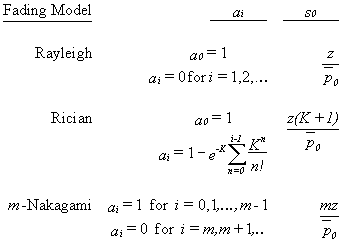
 |
JPL's Wireless Communication Reference WebsiteChapter: Wireless Channels
|

where we insert the appropriate pdf of received wanted signal power
![]() and interfering signal power
and interfering signal power
![]() .
These pdfs can for instance be derived from a Rician, Nakagami or Rayleigh distribution.
.
These pdfs can for instance be derived from a Rician, Nakagami or Rayleigh distribution.
The joint interference signal pt is the sum of the powers of each individual interfering signals. For independent fading and independently modulated signals, the pdf of the joint interference power is the convolution of the pdf of individual interference powers.
In the special case of a Rayleigh-fading wanted signal, the integral over y can be solved analytically: Inserting the exponentially distribution of wanted signal power, we get



where L{f,s} denotes the one-sided Laplace transform of the function f at the point s.
 SPEC | A special purposed embedded calculator (SPEC or spreadsheet) is available that evaluates the outage probability in a Rayleigh fading cellular channel, with path loss and shadowing. It also considers interference, man-made and AWG noise and delayed self interference. |
This approach can be applied to a Rician-fading wanted signal, using the series expansion
![]()
for the modified Bessel function I0. This gives

Using the properties of the Laplace Transform, this can be written as
![]()

For both models, this probability can be expressed in the same (generalized) form
![]()
Table 1 gives the appropriate coefficients ai and argument s0 for various propagation models.

 Computational Method
Computational MethodThe probability of a signal outage at signal-to-interference ratios sufficiently above 0 dB ( 0 >> Ept ) is found from the behavior of the Laplace expression at small values for s. We expanding the Laplace transform into the McLaurin series
![]()
For Nakagami fading with integer m, this is gives the outage probability

For Rician fading, we find
